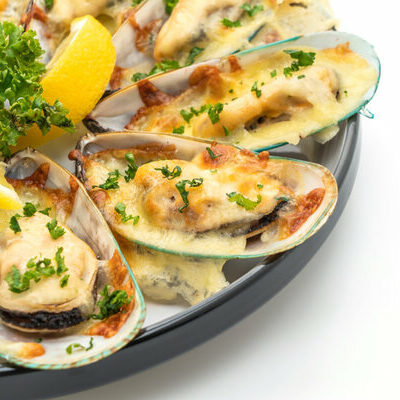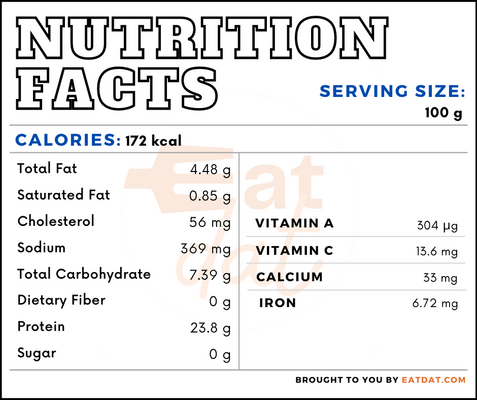
Mussels
What are Mussels?
Mussels are a type of seafood. They are a kind of edible mollusk with a shell that has an outline which is elongated and asymmetrical. The hard outer shell is often dark blue, black, or brown in color while the meat inside is silvery and iridescent.
- This seafood has a mild fishy taste and a soft and chewy texture.
- As a food, mussels are popular in some cultures, especially in regions bordering a coastline, and includes a large variety of different species.
The top 10 most famous mussels dishes around the world include:
- Moules-frites (Belgium)
- Mydia (Greece)
- Midye Dolma (Turkey)
- Midye Tava (Turkey)
- Moules à la marinière (France)
- Dagnje na buzaru (Croatia)
- Mejillones en escabeche (Spain)
- Tigres (Spain)
- Sate Kerang (Indonesia)
- Impepata di cozze (Italy)
Origin of mussels
The earliest archeological evidence points to the consumption of this shellfish over 164,000 years ago by prehistoric humans in South Africa. They have been consumed in all coastal areas around the world. However, intensified mussel farming began in Europe, especially in Spain and Italy, in the 20th century. Although these mollusks are popularly enjoyed in this region, with advances in food technology and distribution, they can be found all over the globe.
Nutrition
Nutritional profile for mussels (100 gms, cooked):

Mussels are rich in phosphorus, potassium, sodium, and vitamin A. Also, they contain calcium, iron, magnesium, manganese, selenium, vitamin C, folate, vitamin B-12, and retinol. Regular consumption of this mollusk may help in improving T-cell immunity and reducing diseases related to the thyroid hormone. Additionally, it may help in reducing the risk of cardiovascular diseases, and increasing cognitive and bone health.
However, the concentration of toxins such as arsenic and cadmium in farmed varieties are disproportionate, and may lead to certain health problems. About 10 percent of the world’s population also has shellfish allergy, making this food potentially dangerous for them.
Commercial production
China is the main producer of mussels, followed by Chile, Spain, New Zealand, Italy, France, South Korea, the Netherlands, Denmark, Thailand, Canada, and Greece.
There are different ways of farming these mollusks. Grown mussels are hung in a group and administered thermal shock. This induces the spawning of larvae, which swim around in the water for the first few weeks, and then attach themselves to the ropes spread out over the coast. Then, they are moved and spread out, so that they can grow fat to their full potential. Finally, they are harvested by hydraulic powered systems or dredges, and sent to be washed, declumped, debyssed, and graded, before being packaged.
Mussel recipes
This seafood is most typically served steamed or baked, but may also be fried or made into soups, stews, and curries. They may be served stuffed or with rice and other main dishes. These mollusks also pair well with white wine, raki, and vermouth. Here are a few recipes.
- Midia Saganaki
- Caldeirada
- Tigres
- Mejillones en Escabeche
- Paella
- Moules à la Normande
- Moules Bisque
- Sate Kerang Hijau
- Kupang Masal Lemak
- Vegetable and Rice Ragout
- Klong Talay
- Maki
- Dynamite Mussels
- Kare Kare
- Cioppino
- Miso Soup
- Honghab Tang
- Honghap Jjim
- Honghap Miyeokguk
- Jjamppong
- Kallumakkaya Varattiyathu
- Arikadukka
FDA regulations
The FDA classifies mussels under the category of molluscan shellfish, which it defines as any edible species of fish, clams, mussels, etc. when the product consists of shucked adductor muscle. Additionally, the FDA strictly regulates the safety levels of these products. Import into the US is also under the strict scrutiny of the FDA and certain specified standards must be adhered to.
References
Safe Eating of Shellfish, Oregon Health Authority, https://www.oregon.gov/oha/ph/HealthyEnvironments/Recreation/Documents/Shellfish-safety.pdf
“How to Grow Mussels.” National Science Foundation, National Science Foundation, www.nsf.gov/discoveries/disc_summ.jsp?cntn_id=132832.
Production Methods for Blue Mussels, The Fish Site, https://thefishsite.com/articles/production-methods-for-blue-mussels
Rodríguez-Hernández, Ángel et al. “Dietary Intake of Essential, Toxic, and Potentially Toxic Elements from Mussels (Mytilus spp.) in the Spanish Population: A Nutritional Assessment.” Nutrients vol. 11,4 864. 17 Apr. 2019, doi:10.3390/nu11040864, https://www.ncbi.nlm.nih.gov/pmc/articles/PMC6521244/
